大阪の柱時計
Clocks in Osaka
日本時計株式会社製 大阪府 明治29(1896)年~明治30(1897)年頃
歴史のページで書いていますが、明治初期から徐々にたくさんの我が国の時計メーカーができてきます。(歴史のページ参照)
東京、名古屋、京都、そして大阪が明治時代の時計の生産拠点となり、我が国の時計産業は発達してきました。
大阪の時計メイカーは当時二十数社の会社や工場があり、精力的に時計の生産を行っていましたが、全国的な価格競争に苦戦するメーカーが多く、短時間で柱時計から懐中時計へと方向転換したり、廃業、解散に追い込まれたりしてその多くは消えていきました。したがって大阪でつくられた柱時計は少ないため、出会いを求めていました。
右の時計は、そんな時代の荒波に揉まれながら生まれてきた「日本時計株式会社」製の一台といってもいいのではないかと思います。
この時計は下記に示すように特異性を持っています。その特異性がこの時代の大阪の時計産業の状況の一端を語っているようにも思います。
この時計の特異性については、当時同じ大阪で操業していたもう一つの時計メーカーである、「松下時計製造所」の存在をあげなければなりません。このメーカーは、明治27(1894)年に、松下房次郎が大阪に設立した時計製造所で、優秀な柱時計の製造を行っていました。しかしながら、明治29(1896)年、松下時計製造所は、日本時計株式会社に吸収合併されてしまいます。
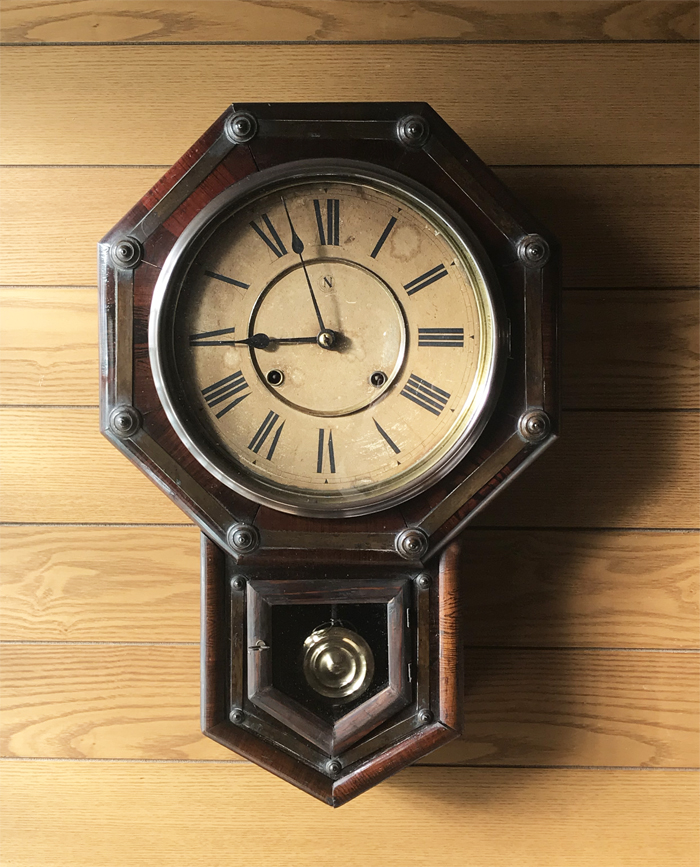
As described on History Page in this site, from the beginning of Meiji period, a lot of Japanese clock makers were gradually established. (Refer to History Page)
Tokyo, Nagoya, Kyoto and Osaka were the production base areas, and Japan’s clock industry has developed there.
There were about twenty-odd companies or factories in Osaka, and were producing clocks energetically. But there were not a few makers struggling with price competition nationwide, so in a short time, many of them had to get out of the clock business, or change to pocket watch making, and many have disappeared. Therefore, as clocks made in Osaka are few, I have wanted to meet one.
The clock in the photo is made by Nippon Clock Co.. It can be said that this clock is one of those that were born in such a rough sea of that era.
This clock has a singularity showed below. It seems to tell us the sever situation of clock production in Osaka at that time.
The singularity of thia clock must be attribute to another clock maker operating in Osaka at the same time, Matsushita Clock Factory. It was established in 1894(Meiji 27) by Matsushita Husajiro in Osaka, making excellent clocks.
However, it has been acquired and merged by Nippon Clock Co..
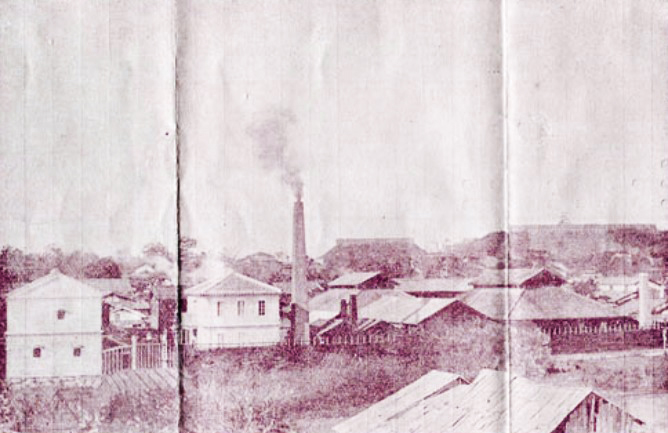
日本時計株式会社 明治33年頃 大阪東区森之宮
(写真 ウエブサイト Timekeeper より)
Nippon Clock Co. around 1900(Meiji 33) Morinomiya Osaka
(photo from web site Timekeeper)
日本時計株式会が、明治29(1896)年、松下時計製造所を吸収合併した後、社長 河辺 九良三郎は、時計の生産を精力的に行い、最盛期(明治31[1898]年頃)には、左写真のような大工場を有し、年間35万台を生産、従業員は200名という大阪では最も大きい時計会社に成長しました。
(*京都時計製造会社では、年間1万4000台程度だった)
In 1896 (Meiji 29), Nippont Clock Co. acquired and merged Matushita Clock Factory.
President Kawabe Kurozaburo did his best to produce clocks earnestly, At its peak (around 1898[Meiji 31) , he had a big factory as the left photo. The company had grown into the largest clock company in Osaka with annual production of 350,000 units and about 200 employees.
(*The annual production of Kyoto Clock Factory was about 14,000.)
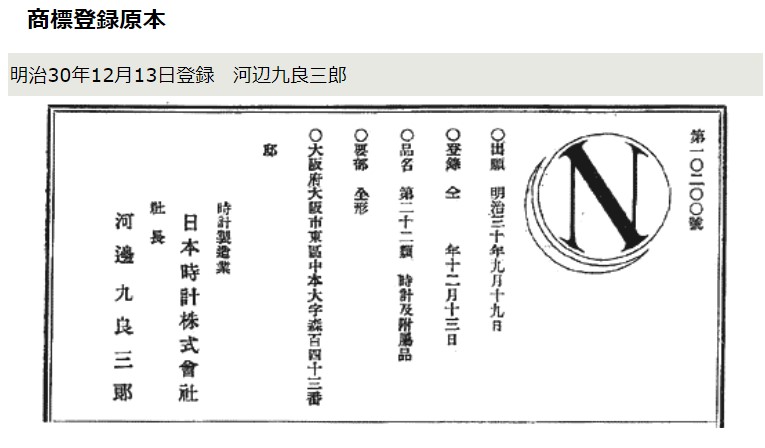
商標登録原本
(ウエブサイト Timekeeper より)
Original Registered Trademark
(From the website Timekeeper)
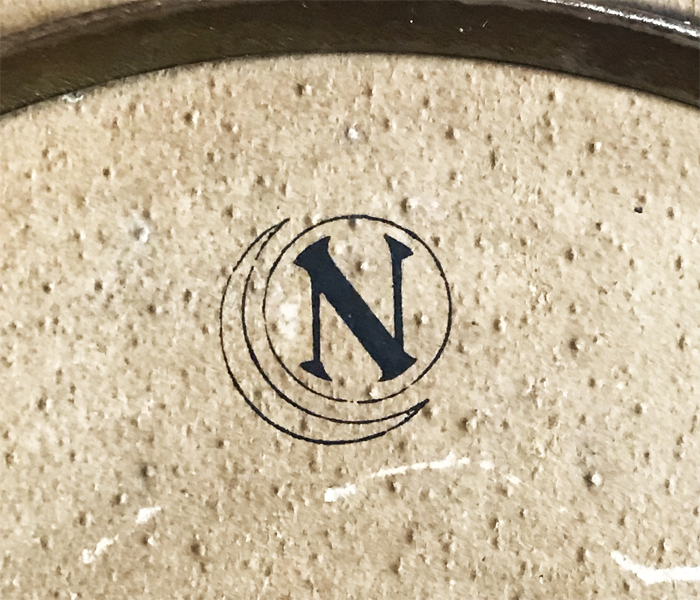
本機文字盤のトレードマーク
The trademark on this clock face
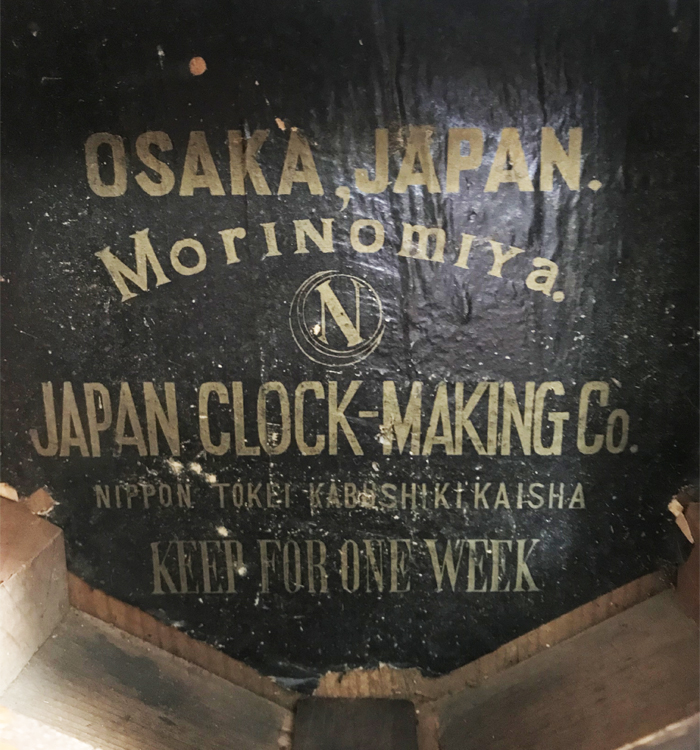
本機振り子室のラベル
The label in this pendulum house
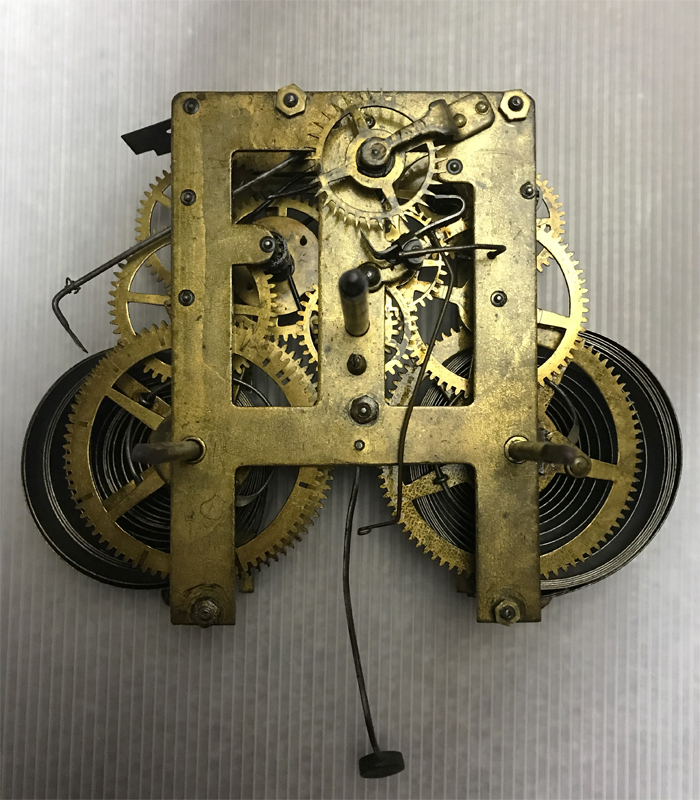
=本機の機械=
日本時計(右)の機械とよく似ているが、
本機は、下の松下時計の機械と全く同じである。
The machine of this clock resembles the Nippon Clock’s (right), but
it is completely the same as Matsushita’s machine. (below)
似て非なるもの 本機の機械
Similar but different The mechanism of this machine
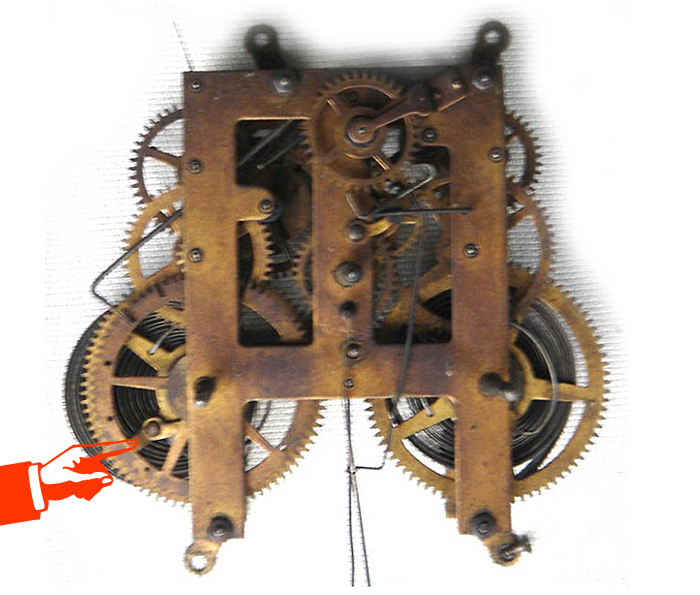
松下時計機械、時報用スプリング、戻り止めピン(左スプリング)
(松下時計は、左巻き仕様=右には巻けない)
(写真 Timekeeper より)
The machine of Matsushita Clock Co. The pin (red hand points) to stop the return of the gong spring (left side spring)
(Leftward roll specification. Can not roll rightward)
(photo from Timekeeper)
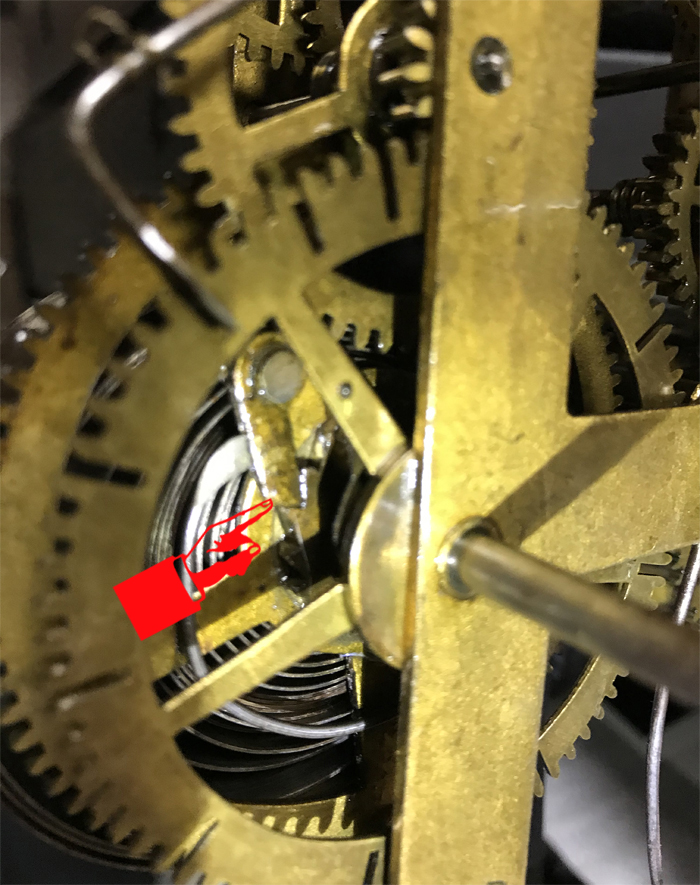
本機の時報用スプリング、戻り止めピン
(左巻き仕様=右には巻けない)
The machine of this clock
The pin (red hand points) to stop the return of the gong spring
(Leftward roll specification. Can not roll rightward)
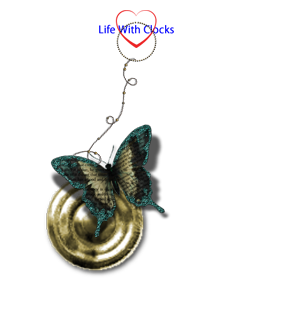
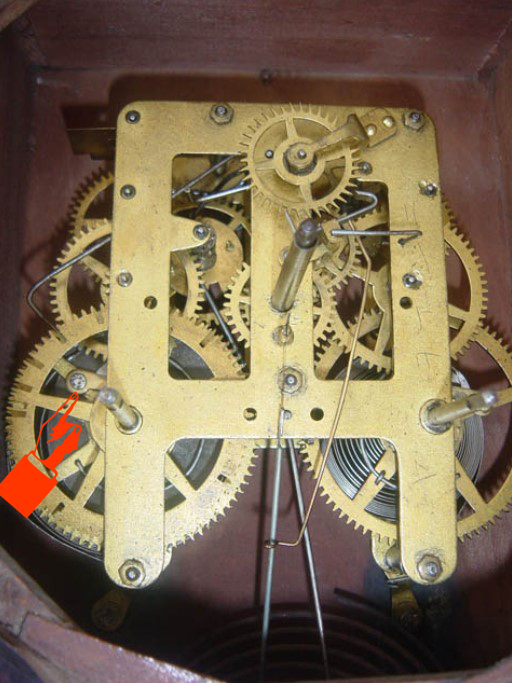
=日本時計株式会社の機械= ( 写真 Timekeeperより )
①プレートの角が丸くなっている。29年以降に日本時計株式会社で製作したものと思われる。
②時報用スプリング戻り止めピン(右巻き仕様=左には巻けない)
=The machine of Nippon Clock Co.= (photo from Timekeeper)
①The corners of the plate are rounded.
It seems that it was made after 1896(Meiji 29)by Nippon Clock Co..
②The pin (red hand points) to stop the return of the gong spring shows rightward roll specification. Can not roll to the left.
日本時計と松下時計はお互いによく似ているが、決定的に異なるところは、上記の①と②です。
①は見たらすぐ分かります。②は、見た目には分かりにくいですが、回せば分かります。両社の機構が決定的に異なるところです。
Both of Nippon Clock’s machine and Matsushita’s are resemble each other, but ①and ②shown above are completely different. ①is understandable at a glance. Corners of the plate are rounded. ②is not easy to understand the difference between the two, but if you roll the gong spring shaft which is on the left side, we’ll easily understand that we can not roll leftward.
This is the point that the mechanism of both is decisively different.
本機の文字盤
The clock face of this machine
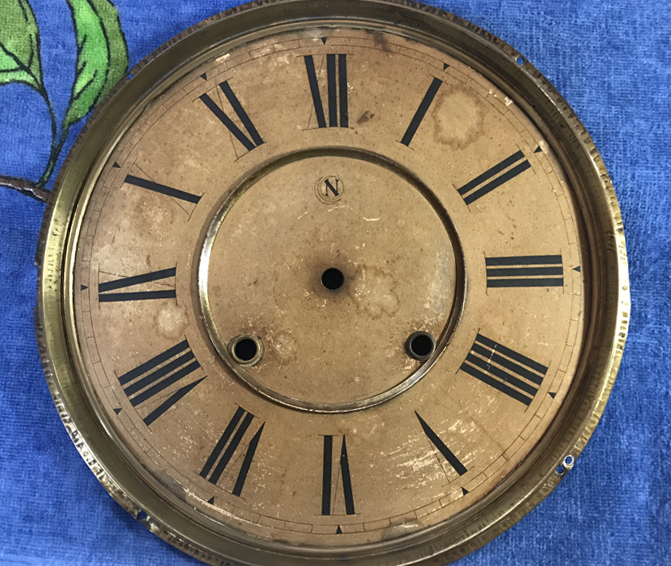
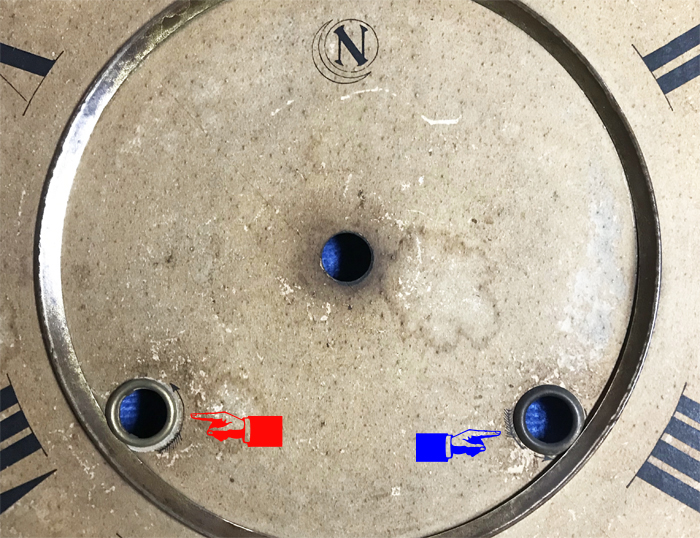
ゴング スプリングキー穴(赤)、時針スプリングキー穴(青)、どちらにも左巻きの←が見られます。
The hole of the gong spring shaft (red), hour hand spring shaft ( blue), Both holes have the instructions ← to roll leftward.
本機のラベル と 商標
The label and the registered trademark
本機は、間違いなく日本時計製であり、ラベルや文字盤のトレードマークからも理解することができますが、肝心の機械だけが松下時計製造所の機械であることが分かります。スプリングキー穴にわざわざ矢印を付けてまで、なぜ松下時計の機械を使ったのか、なぜ日本時計オリジナルの機械を付けていないのか。松下時計の大量の在庫機械があって、合併後流用したのか、それとも日本時計オリジナルの設計ができるまで、松下時計の図面で製作していたのか、明確な情報をお持ちの方は、是非教えていただきたく思います。
冒頭にも言いましたように、この事実の向こうに、当時の大阪の時計産業をめぐる激しい競合が見えるような気がします。そしてそんな荒波の中で生まれた時計の一台が本機かもしれません。
そんな日本時計株式会社も、大阪のみならず全国的な競争に勝つことができず、隆盛からわずか5年足らずの、明治34(1901)年に姿を消すことになります。
そんな荒波の中で生まれて来た、そしてその生みの会社を失った特異な柱時計を眺める時、たかが柱時計といえどもなぜか愛おしさを感じるのです。
資料のほとんどは、ウエブサイトTimekeeperさんにお世話になりました。有難うございました。
Thank you for using the documents from the web site Timekeeper.
It can be understood from its label and clock face that this clock is definitely made by Nippon Clock Co., and that only the essential machine is made by Matsushita Clock Factory. I don’t know why Matsushita’s machine was used instead of Nippon Clock Co.’s original one, even adding arrow instructions to roll leftward on the clock face.
Was Matsushita Clock factory’s large inventory of machines diverted after the merger, or were they manufactured using Matsushita’s blueprints until Nippon Clock’s original machines were designed? Please let me know the reason, if anyone knows about it.
As I wrote at the beginning of this page, beyond this fact, I feel that I can see the fierce competition over the clock industry in Osaka at that time, and this clock might have been born in the midst of such rough times.
However, Nippon Clock Co. was unable to compete not only in Osaka but also in the whole country, and disappeared in 1901(Meiji34), less than five years after its prosperity.
When I look at this unique clock that was born in such a tough situation and lost its company, I feel love about it for some reason, even though it is just a clock.